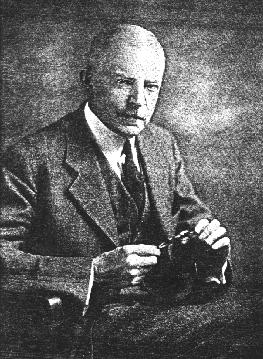August to December 1900
Excerpted from USGS Reports
The Gold Belt of the Blue Mountains
of Oregon
by Waldemar Lindgren
Upper Burnt River Valley and Bonanza Districts
--Placer Deposits--

Many of the creeks in the Clifford Valley have been profitably worked and some have been rich. Among them are, from west to east, Bennett Creek, Camp Creek, Gimlet Creek, and Three Cent Gulch. Placer work has been done in this valley since early days and a production is still maintained.
The gravels washed range in age from Neocene or Eocene to the most recent Pleistocene. The gold is sometimes extremely coarse, as in the Winterville placers, or very fine and floury, as in the ordinary bench gravels of Camp Creek. The fineness is remarkable, some of it reaching $19 to $20 per ounce.
Placer mining is carried on in Three Cent Gulch by Sullivan & Co., who operate one hydraulic jet with 400 miner's inches of water. Gimlet Creek has been worked extensively at the forks above the Sumpter road, and it is said that this locality has produced $100,000. In Camp Creek, at the junction of Pine Creek, 2 miles northeast of Clifford, are the Hindman placers. Here a low bench gravel is worked just above the creek bottom, at this point 200 feet wide. The 10-foot -high bank of well-washed gravel rests on rhyolite. About 70 feet above the creek the heavy bench gravels begin which skirt the eastern side of Clifford Valley. The gold is rather coarse, and has a fineness of 919. It is accompanied by much magnetite and ilmenite, the latter in beautiful crystals. Mr Hindman states that about half an ounce of platinum is obtained at each clean-up. This is the only occurrence of platinum thus far known from the Blue Mountains. The heavy bench gravels are, as a rule, too poor to pay for washing, but contain some flour gold with the fineness of 970.
The placers of Winterville and Parkerville are unusually interesting. The Winterville diggings are located on Bennett Creek, three quarters of a mile south of the Bonanza mine and at an elevation of 4,900 feet. The placers have been worked intermittently for many years and have doubtless yielded a large sum in aggregate. According to Mint reports they produced $25,000 in 1889. During 1900 they were in active operation and the production is supposed to have been over $20,000. The water is obtained from the Mann Ditch, which, with an aggregate lenght of 30 miles, taps the headwaters of Clear Creek and Olive Creek and is said to have a capacity of 5,000 miner's inches
At Winterville the creek leaves the andesite and for half a mile below flows over bed rock of slate and serpentine. In this distance the gravels along the creek bed have been worked. The gravels washed at present are found about the level of the creek and on its western side. The area which thus far has been hydraulicked comprises about 3acres, the banks being from 15 to 20 feet high. The bed rock is a serpentinoid greenstone of uneven surface. A north-south fault in the bed rock has been exposed 100 feet long and showing a scarp 30 feet high which dips 60 deg. E. The pay gravel, resting on the bed rock, is from 3 to 10 feet thick, not very coarse, and somtimes cemented. The gold, found chiefly on the bed rock, is extremely coarse, the pieces ranging from 0.05 ounce up to 15 ounces in weight, but at the same time very well washed. Most of the nuggets have an oblong, flat shape. The fineness averages 900. This interesting deposit was clearly formed before the time of the Neocene andesitic eruption and must be of Eocene or early Neocene age. The high bed-rock hills rising on the southwest side and the general configuration of the country indicate that it was a narrow gulch of an upper drainage system which had a general east-west direction across the present creek. The increasing height of the banks will soon interpose difficulties for continued hydraulic work. The bed rock seems to pitch downward at present and at its deepest point probably lies below the level of the creek. Inclines sunk will probably develope a heavy flow of water. On the other hand, if the channel came down from the west, and there is little doubt of this, it would seem feasible to follow it up by a drift from the present bed-rock level.
Two miles west of Winterville are the Parkerville diggings, which are reported to have produced $150,000. They are said to be similarly situated and may represent the continuation of this channel. The continuation of the channel east of Winterville has not been found and the probability is that it would be considerably below the present level of the valley.
These stories are available to our electronic readers as part of our contribution to the information available on the Internet. We're interested in hearing from you especially if you've been to Eastern Oregon, the Wallowas, the Blues, or if you know of Prof. Lindgren and his trips to the many other gold camps in the West. These stories are available to our electronic readers as part of our contribution to the information available on the Internet. We hope you enjoy the stories and if you have questions or comments please send a message to editor, Keith Whittle
More on Waldemar Lindgren:
[Editor's Introduction | "Gold Belt of Eastern Oregon"]Read our other gold mining editions:
[Sumpter, Oregon 1900 | Gold Seekers Rush to California]
[ Oregon: Land of Gold & Opportunity | Dequille Reports from the Comstock]

Bridget E. Smith, editor & publisher
Email | Home Page | Historic Headlines
Historical Gazette
Published in Portland, Oregon
© 1991-

